Nuremberg
![]()
The title of this article is ambiguous. For other meanings, see Nuremberg (disambiguation).
Nuremberg (nürnbergisch often Nämberch) is a Franconian district-free city in the administrative district of Middle Franconia in the Free State of Bavaria.
With a population of around 520,000, Nuremberg is the second largest city in Bavaria after Munich and is one of the 15 largest cities in Germany. Together with its direct neighbours Fürth, Erlangen and Schwabach, Nuremberg forms one of the three metropolitan areas in Bavaria with around 800,000 inhabitants. Together with their surrounding areas, these cities form the Nuremberg conurbation, with over 1.3 million people and the economic and cultural centre of the European Metropolitan Region of Nuremberg, which has almost 3.6 million inhabitants and is one of the eleven metropolitan regions in Germany. Nuremberg is one of Germany's major cities with a distinctly multicultural society.
The city of Nuremberg was first mentioned in documents as early as the Sigena charter of 1050, and experienced its first heyday as an independent imperial city of the Holy Roman Empire from 1219 onwards. Before the severe destruction of the Second World War and the very simplified rebuilding of the post-war period, Nuremberg's medieval old town was considered one of the most important in Europe. However, some landmarks were rebuilt true to the original, especially the city's churches. In addition, some architectural monuments were preserved. Among the most important landmarks are some buildings along the historic mile, especially the Nuremberg Castle. In addition, other noble buildings and castles of the old HRR imperial city have been preserved.
Nuremberg's Christmas market, the Germanic National Museum and several other museums are also of national importance. The city achieved global awareness in the 20th century during the National Socialist era, when the annual Nazi Party Rallies were held on the Nazi Party Rally Grounds and the Nuremberg Laws were passed. After the Second World War, on the other hand, the city became the scene of the first judgments based on international criminal law with the Nuremberg Trials and earned the title of City of Human Rights. Economically, the service sector, cutting-edge technology, industrial production (including electrical engineering, mechanical engineering and automotive parts) and the Nuremberg Trade Fair (including Spielwarenmesse, Consumenta, GaLaBau, BIOFACH, IWA OutdoorClassics, BrauBeviale) are of great importance. Nuremberg is also the seat of the state authorities Federal Employment Agency and Federal Office for Migration and Refugees.
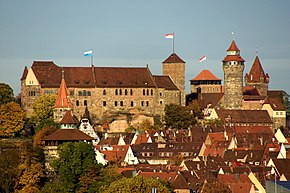
Nuremberg's landmark, the Kaiserburg

View from the Burgberg to the wintry old town, in front on the left the roof of the Frauenkirche as well as the old town hall, in the middle the church St. Sebald, behind it the dome of the opera house, on the left St. Lorenz, the dome of the main station and the Frauentorturm, on the right the Weißer Turm, the dome of the Elisabethkirche and the Spittlertorturm as well as at the edge in outlines the Fernsehturm.
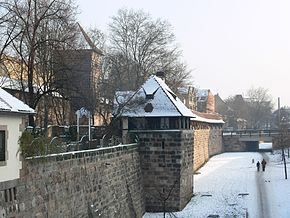
The city wall still encloses the old town almost completely today
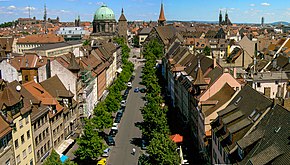
View over the old town from the Spittlertor tower
Name, coat of arms and signet
→ Main article: Coat of arms of the city of Nuremberg
The name of the town is derived from nor for "stony rock" and referred to the Keuper rock visible from far away with the castle. It and the settlement that developed at its feet were probably named after the Felsberg. There is also the theory that the name of the town derives from the personal name Noro. Other interpretations like "Nero-berg", "Nur-ein-Berg" or "Neuberg" proved to be wrong.
The epithet Noris already appeared in humanism. Helius Eobanus Hessus first referred to Nuremberg as "noris amoena" (lovely Noris). Hessus based this on the Latin spelling of the city's name in documents as "Noricum", "Noribergae" or "Norimberg". In 1650, the physician Johann Helwig personified this epithet in a poem as the mythical nymph Noris, which has since been frequently used as an educational allegory of the city.
| Large coat of arms | |
|
| Blazon: "On a light blue ground a golden eagle with a natural colored youthful royal head wearing a golden crown of leaves and framed by hair flowing down. “ |
| Coat of arms justification: This coat of arms was already used in the seal of 1220 and symbolizes the empire (Reichsstadt). The head was at times represented as a woman's head. In its present form, the Great Coat of Arms was granted in 1936 and confirmed by the City Council in 1963. It is usually used in official seals (but not by the registry office, which uses the official Bavarian coat of arms), by mayors and the city council, and on historic municipal buildings, and may only be used by associations or companies with an exceptional permit, which is rarely granted. |
| Small coat of arms | |
|
| Design: "In a split shield on the right golden half the half black imperial eagle with red tongue, golden muzzle and golden beak, while the other half is divided five times diagonally right, starting with red at the top and alternating in the colours red and silver." |
| Coat of arms justification: The diagonal division can be traced back to 1260. The imperial eagle was added from 1350 and thus represented the reverse seal. Since 1513, this depiction was used in the seals of Nuremberg's offices and external authorities, whereby the number of slanting bars and the colouring varied several times. The form still in use today was awarded in 1936 together with the Great Coat of Arms. |
Both city coats of arms are subject to approval.
|
| The city flag is also derived from the Small Coat of Arms. The Small Coat of Arms may be used for advertising purposes by companies based in Nuremberg or affixed to goods, as long as the impression of official use is not created and the coat of arms is reproduced in a heraldically and artistically correct manner. |
The city has used a signet in addition to the traditional coat of arms since the 1970s. The original signet, also called logo, showed a stylized N, reminiscent of the side of the Small City Coat of Arms divided by red and silver. In 1993, a city logo was then developed that took up the elongated silhouette of Nuremberg Castle and established itself as the city's distinctive sign. However, it was not possible to develop a uniform corporate design from this. In addition, the old logo proved to be inflexible due to its horizontal shape. In 2009, therefore, efforts were made in the city hall to develop a more manageable logo and a more uniform appearance. Since July 2011, the new city logo and corporate design has been gradually introduced. In addition to the city logo, the logo of the metropolitan region of the same name is also frequently used by the city. This is intended to increase public awareness of the connection between the city region and the metropolitan area with the neighbouring districts.
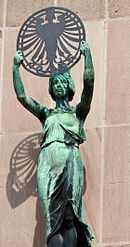
Bronze figure of the nymph Noris (1903) by Philipp Kittler

Logo of the Nuremberg Metropolitan Region

City logo
Geography
Geographical position
Nuremberg lies on both sides of the Pegnitz, which rises about 80 kilometres northeast of the city and crosses the city area from east to west over a length of about 14 kilometres. In the area of the old town, the river has been heavily canalized. In the western district of Doos, the Pegnitz leaves the city at Nuremberg's lowest point at an altitude of 288 m above sea level and joins the Rednitz in Fürth, where it forms the Regnitz together. Especially in the north and northwest of Nuremberg, the landscape is strongly influenced by the alluvial deposits of the Pegnitz. In the north of Nuremberg is the Knoblauchsland, an important vegetable-growing area. The Nuremberg Reichswald forest extends to the south, east and north of the city.
The subsoil of Nuremberg consists of soft sandstone, which was formed in the Keuper period. North-east of Nuremberg is Franconian Switzerland, a low mountain range with an altitude of over 600 metres above sea level in places.
Extension of the urban area
The area of the city covers an area of 186.38 km². In the west, the development has grown together with the neighbouring city of Fürth and in the southwest with Stein. To the north of the city lies the relatively flat fertile Knoblauchsland, which also forms the western approach corridor for Nuremberg Airport, and to the northeast the Sebalder Reichswald forest.
The northern boundary of the Old Town is formed by the Burgberg with Nuremberg Castle and the city wall, large parts of which have been preserved; a little to the east, also on the north side of the Pegnitz, rises the park-like Rechenberg.
City breakdown
→ Main article: List of districts of Nuremberg and Statistical division of Nuremberg
In 1968, the city area was divided into 87 Statistical Districts and into blocks for planning purposes in the sense of a small-scale division. These Statistical Districts are grouped into 10 Statistical City Districts. However, this administrative division hardly plays a role in the consciousness of the population, rather in everyday life one orients oneself by the traditional names of the places.
Incorporations
→ Main article: Incorporations into the city of Nuremberg
By 1825, the city area covered 160.84 ha. Since then, after the population of the city had increased more and more as a result of the Industrial Revolution and the city had expanded more and more, several formerly independent municipalities were incorporated into the city area, so that today the city has an area of about 186.4 km².
Neighboring communities
The city of Nuremberg borders on the following cities, municipalities and municipality-free areas (starting in the north, following clockwise):
Erlangen (independent city), Neunhofer Forst, Kraftshofer Forst and Erlenstegener Forst (Erlangen-Höchstadt district), Schwaig bei Nürnberg, Laufamholzer Forst, Zerzabelshofer Forst, Forsthof, municipality-free area Fischbach, Feuchter Forst and Feucht (all administrative district of Nürnberger Land), Wendelstein and Forst Kleinschwarzenlohe (administrative district ofRoth), Schwabach (independent city), Rohr (administrative district of Roth), Stein and Oberasbach (administrative district of Fürth) and Fürth (independent city).
The exclave of Brunn, which has the highest point of Nuremberg at 406 m above sea level, is bordered by the municipalities of Brunn, Winkelhaid and Fischbach (all in the district of Nürnberger Land).

enlarge and show information about the picture
![]()
Panorama from the castle liberation over the old town
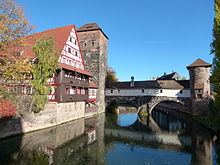
Pegnitz bridge with Weinstadel

Statistical districts and city districts in Nuremberg

Nuremberg's city structure and its surroundings
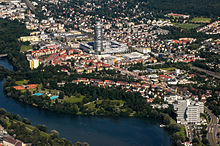
The district of Tullnau to the east with the Wöhrder See lake, the Norikus housing estate and the Business Tower, which is already in the Mögeldorf district.
Questions and Answers
Q: What is the name of the German state where Nuremberg is located?
A: Nuremberg is located in the German state of Bavaria.
Q: How many people lived in Nuremberg as of June 2017?
A: As of June 2017, 530,771 people lived in Nuremberg.
Q: What river does Nuremberg sit on?
A: Nuremberg sits on the river Pegnitz.
Q: Is it Franconia's largest city?
A: Yes, it is Franconia's largest city.
Q: How far away from Munich is it?
A: It is about 170 kilometres (110 miles) north of Munich.
Q: Does the Rhine-Main-Danube Canal pass through Nuremberg?
A: Yes, the Rhine-Main-Danube Canal passes through Nuremberg.
Q: How do you pronounce "Nürnberg" in German?
A:"Nürnberg" is pronounced [ˈnʏʁnbɛʁk] in German.
Search within the encyclopedia
.svg.png)
.svg.png)
